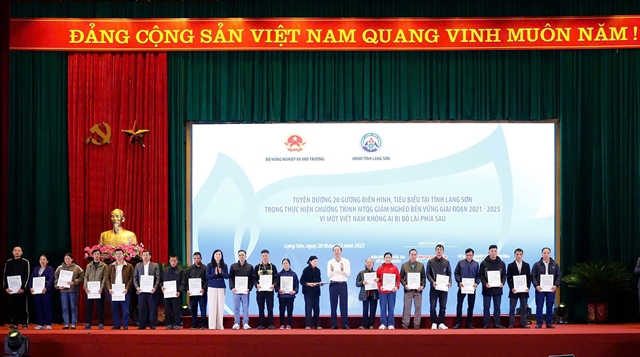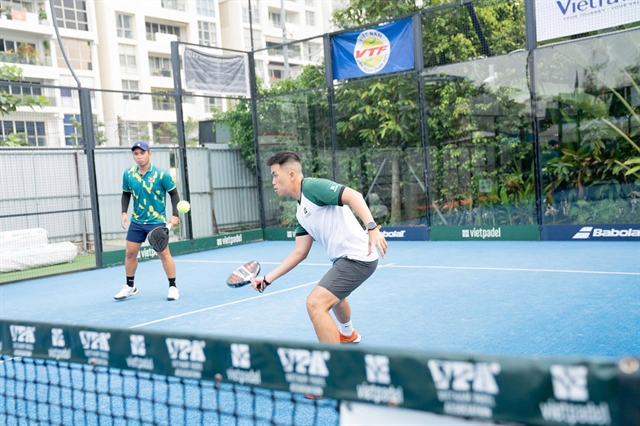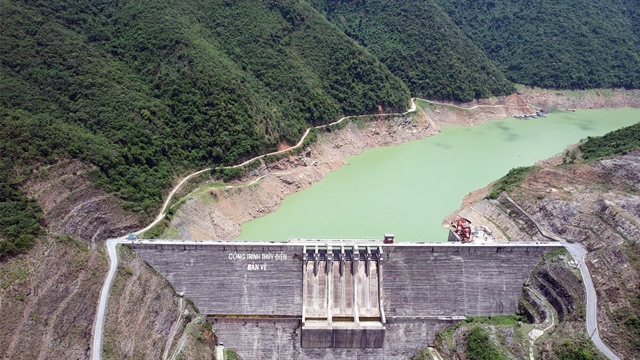 Society
Society


|
| Bản Vẽ hydroelectric reservoir, the largest in Nghệ An, is nearing the dead water level, which is the same situation many hydroelectric reservoirs in Việt Nam is facing. — VNA/VNS Photo Tá Chuyên |
HOÀ BÌNH — Two out of the three largest hydroelectric reservoirs in Việt Nam, Sơn La and Lai Châu are at dead water levels, with only Hoà Bình reservoir having enough water to generate electricity.
The inability to mobilise electricity from hydroelectric power plants has affected the management and operation of the power system, as well as people's daily lives and the production of businesses.
In the first days of June, Sơn La hydroelectric reservoir recorded a water level 30 to 40 metres lower than the allowed level of 215 metres above sea level.
Mai Đức Tiệp, a supervisor at Sơn La Hydroelectric Plant, stated that since the first turbine went into operation in 2010, this is the first time that the water level of the Sơn La reservoir has dropped to a record low, and the plant has had to operate below the dead water level of 175m.
"In the past few, scorching hot, days, all six turbines were operational. However, in recent days, the turbines have almost stopped operating, and if they can run, it is very limited because the reservoir has reached the dead water level," said Tiệp.
At the central operating area of the plant, six engineers are working tirelessly to monitor the operating system. Although the five turbines have stopped operating, they are kept in a state of readiness to generate power when needed.
Tiệp added: "Under the condition of the dead water level, the water column of the turbines decreases, the draft tubes are at risk of vibration, and the turbines may become unstable. The temperature of the turbines also tends to increase, so the plant has arranged for additional personnel to inspect the equipment and increase the frequency of inspections.
"Under normal conditions, the turbines are inspected once every two hours. However, when operating below the dead water level, inspections need to be conducted every hour or every 30 minutes to ensure that everything is in good working order and ready to supply electricity to the grid upon demand."
He also mentioned that at the lower downstream area of the plant, the unit takes advantage of the situation to perform dredging activities to increase the power generation capacity.
Located approximately 300km upstream from the Sơn La hydroelectric dam, the Lai Châu Hydroelectric Plant is almost non-operational as it has fallen below the dead water level by 5m.
"This is the first time that both the Sơn La Hydroelectric Plant and the Lai Châu Hydroelectric Plant have been operating below the dead water level," Khương Thế Anh, director of Sơn La Hydroelectric Company, told Tuổi Trẻ (Youth) newspaper.
According to Thế Anh, the monsoon season in 2022 in the river basin ended early, resulting in decreased water storage in the reservoirs. Particularly in the first months of 2023, the water inflow to the Sơn La and Lai Châu reservoirs was only 51 per cent compared to the same period in 2022.
Due to the lack of water accumulation in the 11 reservoirs in China, the water inflow to the Lai Châu and Sơn La reservoirs has significantly decreased.
"During this period, we have to halt the turbines for inspection and maintenance, with the goal of providing electricity to the best of our ability," Thế Anh said.
Hoà Bình holding on
Currently, the Hòa Bình Hydroelectric Plant is the only functioning hydropower plant in the Đà River's hydropower system capable of supplying electricity.
Phạm Văn Vương, the director of the Hòa Bình Hydroelectric Company, said in late May and early June, due to a shortage of water resources, the hydroelectric plant had to operate at high capacity, causing the water level in the reservoir to decrease rapidly as there was almost no water flowing into the Đà River basin.
The Sơn La Hydroelectric Plant has already reached the dead water level and can no longer provide additional water supply to the Hòa Bình reservoir.
As of 5pm on June 8, the water level in the Hòa Bình reservoir was only 103.45m, a decrease of nearly 6m compared to two weeks ago, while the water inflow to the reservoir was only about 40 cubic metres per second.
According to Vương, currently, all eight turbines are ready for operation, but the plant has to adjust its operation according to the system's demands. At certain times, it can generate a maximum capacity of 1,920MW, while at other times, the output is lower.
If the high exploitation continues, the water level in the reservoir will continue to decrease rapidly, and the power generation capacity will not be sufficient, affecting the plant's ability to reach its maximum capacity.
Vương also mentioned that the reserve capacity of other hydropower plants in the northern region is almost depleted, and the water inflow to the Đà River basin in June is forecasted to remain low. Therefore, the Hòa Bình hydroelectric plant must ensure reserve capacity while also ensuring reserve production for the future.
Given the current situation, we are coordinating with the National Power Dispatch Centre and are ready to operate according to the system's requirements," Vương said. He also stated that if the plant operates at its maximum capacity continuously, the Hòa Bình reservoir will reach the dead water level (80m) in about 12-13 days. — VNS




